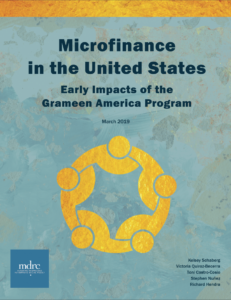 Microfinance in The United States: Early Impacts of The Grameen America Program
Microfinance in The United States: Early Impacts of The Grameen America Program
MDRC
First published March 2019
The first-of-its-kind random assignment study examined 1,492 women (in 300 loan groups) who applied in groups of five to the Grameen America microlending program in Union City, New Jersey. Applicant groups were assigned at random into two groups: those eligible to receive Grameen America loans (the program group) and those not eligible (the control group). The outcomes of the two groups were compared over time. Random assignment studies, often called the “gold standard” of evaluations, use the same rigorous methods as pharmaceutical trials.
Highlights from the early findings of the evaluation of the Grameen America program include:
- More than 94 percent of Grameen America members reported that their financial situation is better than it was the previous year, a 13-percentage point increase over the control group average.
- The Grameen America program produced a 22-percentage point increase in the attainment of a credit score – a VantageScore — at 7–12 months after participants enrolled in the study, and a 6-percentage point increase in the attainment of a Prime credit score, the top tier of creditworthiness.
- Grameen America members were 13 percentage points more likely than their control group counterparts to report that they could afford to buy the things they needed.
- Over 95 percent of Grameen America members reported operating their own businesses 6 months after joining the program, an increase of 11 percentage points over the control group average.
